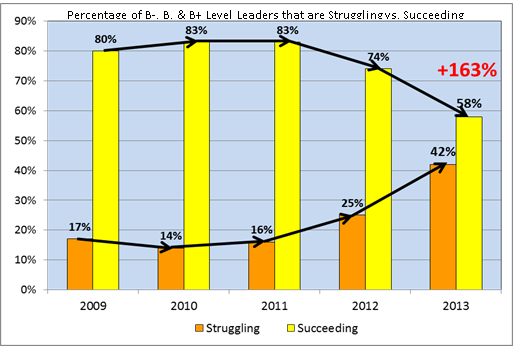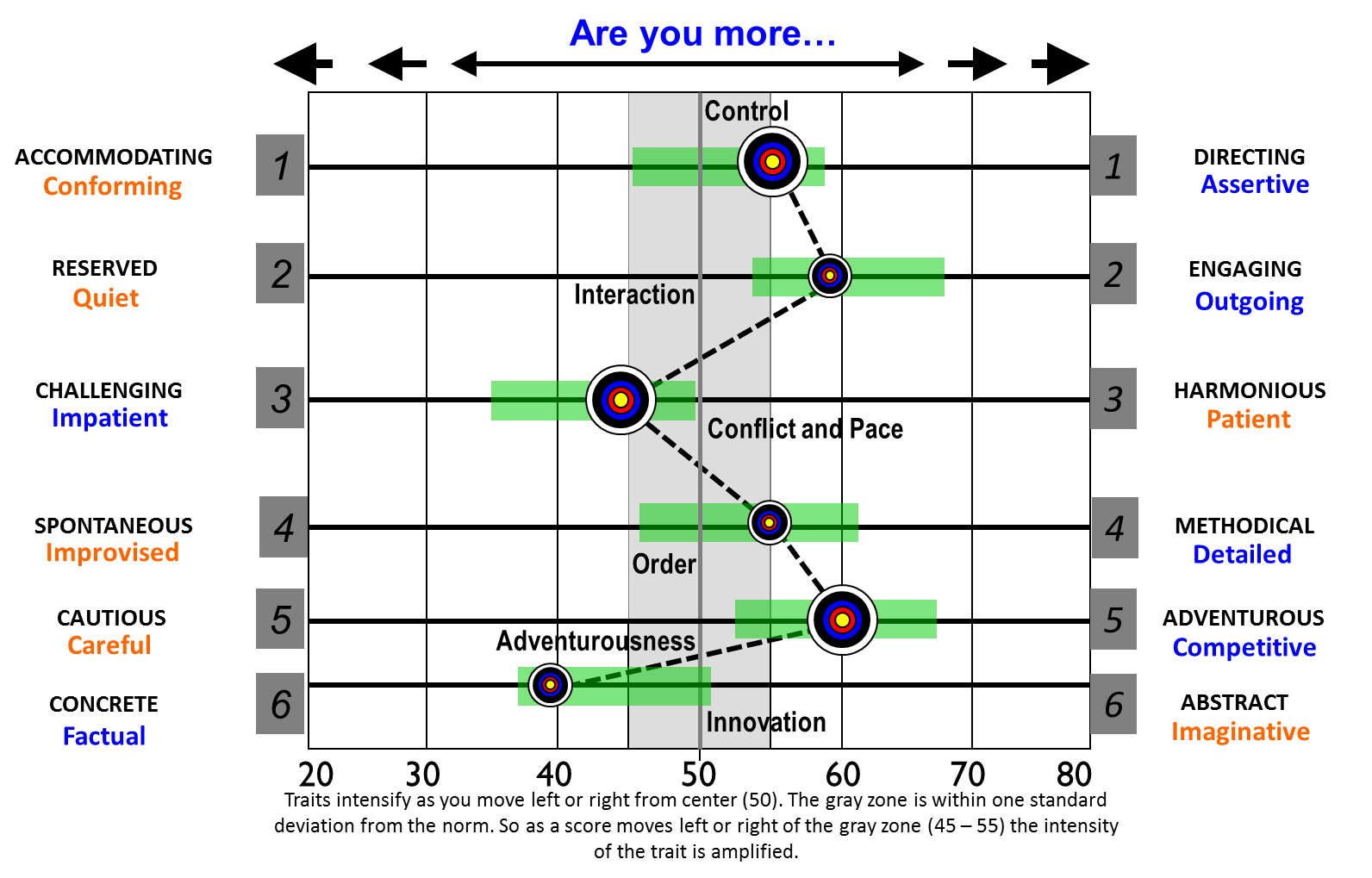An examination into what differentiates the top healthcare leaders.
Hospital and health system leaders are struggling at a much higher rate than they were three years ago. The cause of that increase is an increasingly complex environment. The solution for an individual leader is to seek out development and coaching that will help them to be more effective. The solution for hospitals and health systems is to take a new look at their leadership development, coaching and appointment practices — what they are currently doing isn't working.
Success Profiles, Inc. has been focused on the measurement of healthcare leadership for 12 years. Using proprietary techniques and tools we have evaluated over 30,000 leaders.
Evaluations differentiate the demonstrated ability (i.e., talent) of leaders using categories, respective to a normal bell curve distribution (i.e. A, B+, B, B-, C, and D). Those leaders are also given an overall performance rating (failing, struggling, succeeding or excelling) based on performance metrics (e.g. quality, patient satisfaction, revenue, turnover, staff engagement and culture) achieved within their span of control. For every leader evaluated, measurement was also completed on the complexity of their role. Using further proprietary techniques, those roles are divided into three levels of complexity: low, medium or high. Acknowledging that leading or managing at any level in healthcare is difficult and complex, the differentiation of complexity is still absolutely essential to understand probabilities of success.
Successful leadership becoming increasingly difficult
In 2009, 31 percent of “B-” leaders were struggling. Two years later, that number increased by one-third to 40 percent of “B-” leaders struggling. The rise was significant, but limited to “B-” leaders.
Leaders categorized as “B-” make up 12 percent of the entire population of leaders, and before 2011 that category of leaders were performing similarly to their "B level" counterparts (i.e., B and B+ leaders) in regards to their performance outcomes and demonstrated results.
As a group, "B level" leaders demonstrate good leadership attributes in a semi-consistent manner and are the bulk, 51 percent, of leadership in a typical healthcare organization.
How much the shift in struggling was due to increased complexity and how much of it was due to the consistency of effective leadership was yet to be known.
At the end of 2013, the shift was no longer limited to "B-" leaders; the shift had engulfed both "B" and "B+" leaders. The swell was a 163 percent increase of struggling "B level" leaders over the last three years (see graph below).

Why are more leaders struggling?
Evident in our measurement was that increasing complexity was the major contributor to poor and inconsistent performance outcomes (productivity, revenue, quality, safety, replacement costs, retention, culture, engagement, etc.). A leader today has to show up at an entirely different level of effectiveness to offset the pressures of complexity in their span of control.
"The changes in healthcare’s business model have surpassed the knowledge, skill and experience that many B level leader can bring to the table," says Steve Johnson, CEO of Susquehanna Health in Williamsport, Pa. "And with the complexity of change hitting an exponential level, it is impossible for all but the most behaviorally astute and intellectually agile B level leaders to be successful."
Barbara Price, corporate senior vice president of clinical service lines at Scripps Health in San Diego, agrees that the increasing complexity of healthcare leadership responsibilities is making it more difficult for leaders to succeed.
“We keep piling on the work demanding that more be done with less. For years our answer to every patient need, added regulation, greater intensity, etc., has been to add staff to fulfill the need. Cost pressures have nearly eliminated this option so people are doing more with fewer resources," she says. “As an example, we have done several redesign efforts over the past few years. The immediate impact was excellent — reduced costs, better care and service — in all cases. Six months later all the gains are gone and we are right where we started. We have committed to a Lean-based approach we call Value by Design to correct for many of these gaps your data seems to identify."
What does showing up at entirely different level of effectiveness look like?
The answer is crucial, if an organization is going to be successful in the new ecosystem of healthcare. Healthcare organizations will only succeed if those who are managing and leading individual departments, functions, projects, partnerships and service lines succeed.
This begs the question, "Are the best leaders and managers naturally hardwired differently?"
The answer is yes, regardless of their role in leadership.
This does not mean that the best leaders and managers are clones of one another, with robotic precision programmed for success regardless of the endeavor. Leaders are humans too.
What makes an effective healthcare leader?
For us, it meant we needed a starting point. We needed to find the "prototype" of a highly effective leader, so that we could quantify just how much an individual would need to regulate their natural intensities for the sake of being more effective in their role.
Each leader in our study, a population of 4,208 leaders, completed two assessments that cross-validate each other. One assessment is a four-factor assessment comparable to a DISC assessment and the other a six-factor assessment. We used the six-factor assessment, for its more "MRI-like" ability to provide exceptional detail and precision, to create a prototype for healthcare leaders.
Our initial population of 4,208 leaders provided for us a normal distribution on each of the six factors in the assessment. That population, however, did not by itself tell us what is unique about the best leaders.
Carving out a population of 383 "A level" leaders that had demonstrated the ability to consistently show up effectively and have consistently created cultures of high performance provided us the ability to compare "prototype" leaders to one another and contrast them to the original population of 4,208 leaders. What we found was enlightening and then shocking.
Distinctive hardwiring of effective leaders
According to our analysis of the six-factor assessment, the most successful healthcare leaders exhibited the following characteristics:
- Directing — Assertive yet collaborative with reasoned diplomacy and bluntness
- Engaging — Verbal and social, but not necessarily enthusiastic
- Challenging — Very logical, but still supportive and tolerant
- Methodical — Achieving and structured
- Adventurous — Very ambitious, competitive and willing to take risks
- Concrete — Practical and experience based
We found that the most effective leaders will not sacrifice relationships for results or results for relationships. They put it upon themselves to balance both as effectively as they can, regardless of their natural strengths and preferences.
The graph below illustrates where the top leaders we evaluated fall across the six traits assessed. The green horizontal zones in the graph above are what we term "success zones." Leaders that scored within these zones were significantly more likely to create consistent positive outcomes in their role. As roles increased in complexity, we found that leaders within the "success zones" needed to be scoring more in the direction of the target displayed on the above graph. We termed this as the "sweet spot."
A cross analysis of the behavioral assessments, with the initial evaluations of demonstrated leadership effectiveness, provided us with the probabilities of an individual leader being able to regulate their natural hardwiring, to proactively fit a given situation.
Our findings show that two-thirds of all individuals will have the discipline to self-regulate consistently, up to a five-point shift from their natural hardwiring. This effort takes the self-awareness of the need to regulate, the practice discipline to regulate and coaching to make sure it is done consistently.
With that ability to regulate in mind, we contrasted our population of leaders against the "prototype" leaders and found that on three factors, prototype leaders were significantly more often within striking distance of the "sweet spot."

The three factors that differentiate prototype leaders are :
- Directing — Somewhat Assertive
- Challenging — Somewhat Impatient
- Adventurous — Competitive
As shown in the chart below, "A" leaders who were succeeding or excelling were 18 percent, 14 percent and 10 percent more likely to be directing, challenging and adventurous, respectively, than the population of leaders we evaluated.
The other three factors showed no significant difference between the “prototype” population and the general population of leaders.

So, what sets the best leaders apart from all other leaders?
What is it that makes the best leaders different?
It is their level of directness with others, their desire for results and their self-motivation.
It is those factors that set the best leaders apart from every other leader, and allows them to have complexity piled on, while maintaining successful outcomes.
In conclusion, this should pose several questions.
- How often do you objectively measure the effectiveness of your entire leadership team (managers, directors, executives)?
- What are you going to do to address the 50 percent of your leadership who are now struggling to carry out their roles?
- Do you have a clear strategy to develop their talents and capabilities to meet future demands?
- How well do you understand the behavioral profiles of your current and potential leaders and how often do you ensure that their overall profile matches the complexity of the role for which they may be assigned?
It is well understood that the pool of talent available to you as an organization is shrinking; the time to answer these questions is now.
Tom Olivo is the founding partner in the consulting firm Healthcare Performance Solutions and the president of Success Profiles, Inc. Established in 1990, Success Profiles designs and provides organizational performance measurement instruments and database management services to clients, management consulting firms and professional associations. In his professional career, Mr. Olivo has over 25 years of experience in identifying, measuring and comparing the “commonalities” of highly successful athletes, business leaders and organizations. He has worked in a multitude of industries with thousands of senior executives and managers, emphasizing the importance of business analytics and getting the right people in the right roles

